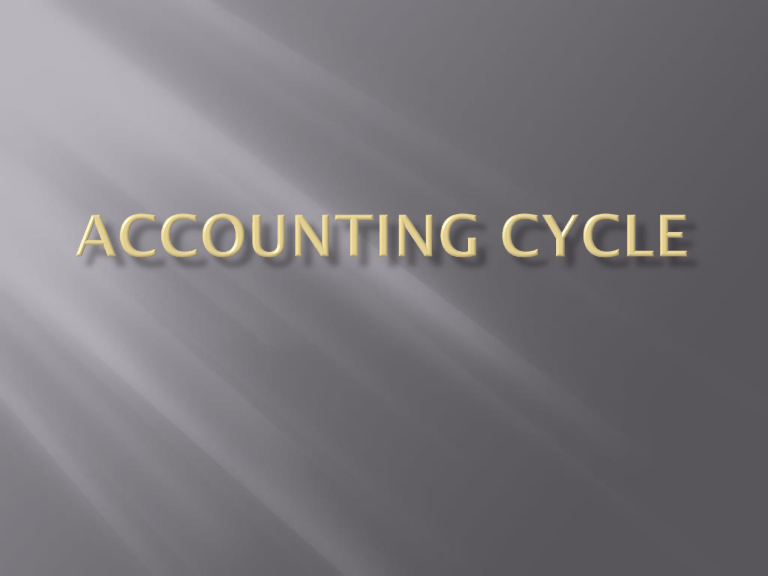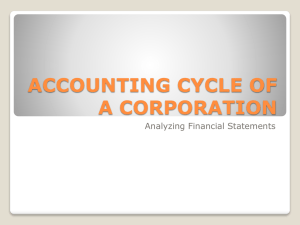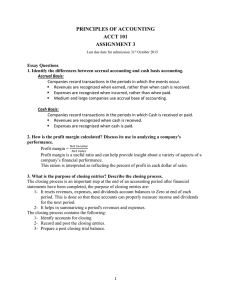Steps in the Accounting Cycle

Business-entity - A business should be a separate entity from the owner of a business
Personal items
Records and transactions
Continuing-concern concept – the business will continue to operate.
Allows assets to be recorded at cost
Remain at that figure no matter what the market value may be
If sold, the assets of the company will be valued at market value to determine selling price
Time-period concept – divides the business into equal periods of time,
ie month, quarter or year
Cost principle – assets are carried at cost on the financial statements
Cost is what was paid for the asset
An item from your home - used value
Matching principle – earnings and expenses are recorded in the period when one benefits the other
ie September expenses are recorded in the same period as September revenue
Consistency Principle – Methods and procedures are kept the same over time.
Allows for better comparison of data
If changed, change and effect must be reported on Financial Statements
Adjusting Entries – Unpaid and/or unrecorded transactions at the end of the accounting period.
Balance Sheet - A “snapshot” of the business’
Assets, Liabilities and Owner’s Equity on a specific date.
Closing Entries – entries made to close (zero out) all temporary accounts at the end of the accounting period .
Income Statement - profit or loss of a business
• Earnings less expenses
• reflects a period of time (usually one month)
Journal – the book of original entry all transactions are recorded here first
Transactions – business papers and source documents that change the financial position of a business
Book of
Original
Entry
Step 1 Business
Transactions occur
Source
Documents
(receipts, invoices, tapes, checks and memorandums)
Book of
Original
Entry
Step 2 Analyze and Record the
Transactions
Information is placed in the
Journal by date of occurance
Book of
Original
Entry
Step 5 Journalize
Adjusting Entries
No source documents
End of fiscal period
To match revenue with expenses in that period
Book of
Original
Entry
Step 6 Post
Adjustment from Journal to
Ledger
General Leger only
Book of
Original
Entry
Step 7 Prepare
Adjusted Trial
Balance
To determine if an error in posting has occurred before
Financial
Statements are prepared
Book of
Original
Entry
Step 8
Journalize
Closing Entries
Close all temporary
( NOMINAL) accounts
Revenue
Expenses
Drawing
Book of
Original
Entry
Step 9 Post
Closing Entries from the Journal to the Ledger
General Ledger only
Book of
Original
Entry
Step 10 Post
Closing Trial
Balance
Permanent accounts only
Book of
Original
Entry
Step 11
Prepare the
Financial
Statements
Basic Statements
Income Statement
Balance Sheet
Permanent Accounts
Assets
Liabilities
Capital
Temporary Accounts
Revenue
Expenses
Drawing
Record Revenue (earnings) and expenses
Cash basis
Cash in Cash out
Accrual basis
Record Revenue & Expenses when earned/incurred
Cash is not the same as revenue
Matching principle
1 st question asked:
Cash
Accrual
Other
Small businesses
Simple to understand
Record cash only when received
Record expenses when cash is paid or check is issued
Record credit card charges when signed for
Combination
Income and expense clearly shown
Consistently
Can not switch between the two
Always use when merchandise is a factor
Production
Purchase
Sale
More difficult to understand
Timing of revenue and expenses
Nothing to do with payments or receipts
All Revenue Only Cash
Not Paid


